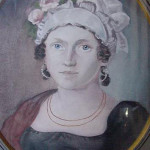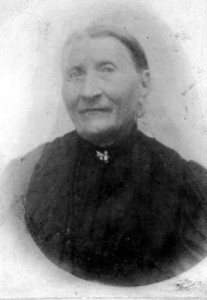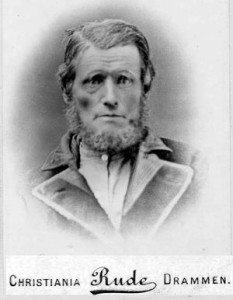Mitochondrial DNA is the DNA in your cells’ mitochondria which only comes from your mother; it is abbreviated to mtDNA. It can be used to learn more about your maternal ancestry although it is slow to mutate. The Y chromosome is passed almost intact from father to son, only a tiny portion at one one end recombines with the X chromosome and it mutates more rapidly; so it is extremely useful for tracing paternal ancestry. All the other chromosomes recombine and the science of using them to find relatives and ancestors is fairly young. That is called autosomal DNA testing. The more large segment matches on chromosomes 1-22 that you have with someone, the more closely you are related. Kitty has ten segments in common with her 2nd cousin Dick Larkin and Shipley has seven. With our Skjold/Wold 2nd cousin we share much more DNA. Kitty has 15 large segments and Shipley has 13 while Dad has a whopping 25 segments. Kitty has five segments in common with her double third cousin and Shipley has seven. See my DNA basics page for more information about what this all means.
So many of my family members have tested their DNA that I have created a special category for them all called Our Family Results. I used to list them all here but there are too many now!
Since the Y chromosome is passed almost unchanged from father to son, the tiny mutations on the Y give us a history of the migrations of the human race. These get assigned to haplogroups on the Y tree so the haplogroup you belong to gives you your deep ancestry. We Norwegian Munsons are R1b-L238 (and more, see below)
Dad tested his Y chromosome at Family Tree DNA so we could get his STR values (see my post on that) and break the brick wall at his 4th grandad. Since then we have tested many SNPs as well to get the deep ancestry from his Y haplogroup.
Kitty started this journey at the National Geographic Genographic Project so has her mtDNA at Family Tree DNA as well as her transferred 23andme results.
For deep ancestry we know these haplogroups:

Direct Ancestor Family Haplogroups as shown in Paul Hawthorne’s colorful ancestry chart
Kitty, Shipley, Stasi, Trudi and presumably all our Thannhauser side first cousins are mtDNA H11 or H11a which goes up the Bavarian Catholic side to Margarette Wittman’s grandmother Veronika Engl. Haplogroup H is the most frequent in Europe at about 40% according to the Europedia article on H. The Wikipedia article claims the H11 subclade of H is mainly found in Central Europe. According to http://www.genealogywise.com/group/haplogrouph11 this haplogroup, H11, is 48,000 years old.
Our German Jewish Thannhauser grandfather‘s maternal mtDNA haplogroup, which goes back to Regina Gundelfinger (1784 -1858) of Regensburg, is now known to be K1a1b1a, a primarily Ashkenazi haplogroup.
Shipley and Dad, so the MUNSON line, are Y haplogroup R1b1b2a1a according to 23andme which uses an older version of the Y tree, aka (R-M269, L52+). Better to use the ISOGG R Haplogroup chart which classifies him and cousins Dick and George as R1b1a2a1a L11/PF6539/S127, L52/PF6541, L151/PF6542, P310/PF6546/S129, P311/PF6545/S128. Actually the latest proposal is to use the terminal SNP for naming so then it would be called R1b-P312. This goes up the Norwegian side from original immigrant Lauritz Andresen (Monsen) to Lars Monsen to his ancestor Mons Knutson Titland of Hamre parish Hordaland. This farm Titland originally belonged to a Scottish noble and this is a Scottish haplogroup so perhaps?
| variant | call | anc | der | |
| R1b1b2a1a defining mutations | ||||
| rs13304168 (L52) | T | C |  |
T |
| rs9785659 (P311) | G | A |  |
G |
| rs9786076 (L11) | C | T |  |
C |
| rs9786283 (P310) | C | A |  |
C |
| R1b1b2a1 defining mutations | ||||
| variant | call | anc | der | |
| rs9786140 (L51) | A | G |  |
A |
We just got back results for the Munson Y that we are positive for P312 so now we are R-P312 aka R1b1a2a1a2 via current ISOGG R page. So of course I could not resist getting the P312 SNP pack to see what more I could learn.
The results are in. We are R1b-L238 (Y11662) which might mean we were Swedish before we were Norwegian (shocking!). L238 is the Scandinavian branch of those European invading R1b warriors with their horses and bronze and Y11662 is the Swedish subgroup (includes some Scots and Norwegians of course). See the migration map here: http://cache.eupedia.com/images/content/R1b-migration-map.jpg
read about us R1b folk here: http://www.eupedia.com/europe/Haplogroup_R1b_Y-DNA.shtml
Cousins Dick and George are listed at 23andme as this same haplogroup even though they are not related to the Munson paternal line in genealogical times! The R1b haplogroup is extremely frequent along the Atlantic and Baltic coasts according to Wikipedia, “The frequency is about 71% in Scotland, 70% in Spain and 60% in France. In south-eastern England the frequency of this clade is about 70%; in parts of the rest of north and western England, Spain, Portugal, Wales and Ireland, it is as high as 90%. (So not surprising that cousin George with French Y-DNA and our 2nd cousin Dick Larkin with colonial English ancestors are also R1b1a2a1a1 aka (R-M269, L52+). According to Europedia which has nice maps, R1b is associated with the indo-european invasion of Europe after the neolithic age. A more in depth advanced discussion of recent R1b research is on the Eurogene Blog
Dad and cousins George and Henry are mtDNA H5a1 which comes to them from Maren Wold Lee’s mother g-grandmother Anna Wold. Sadly this haplogroup is a risk factor for late onset Alzheimers. Anna looks somewhat like a native American so perhaps has Sammi ancestors. Her furthest back known maternal ancestor is Ragnhild Talleivsdtr Selstad circa 1625-1692 Telemark, Norge. This I found from meeting some very helpful Norwegian cousins online who match our autosomal DNA. Other distant relatives had already put her ancestry (the Glaim family) on Geni back to the 1300s.
Dick Larkin is mtDNA T2b which comes to him from our original immigrant ancestress Josephine Halling, wife of Lauritz Monsen, who wrote the family lullaby (her uncles were musical too, we think this is where it comes from in all of us). Her furthest back known maternal ancestress as researched by Dick is Joran Neilsdatter Grundeland, 1691 – October 11, 1769, Sør-Audnedal, Vest-Agder, Norway. Wikepedia describes the mtDNA group T quoting ISOGG this way: “”The mitochondrial Haplogroup T is best characterized as a European lineage. With an origin in the Near East greater than 45,000 years ago, the major sub-lineages of Haplogroup T entered Europe around the time of the Neolithic 10,000 years ago. Once in Europe, these sub-lineages underwent a dramatic expansion associated with the arrival of agriculture in Europe. Today, we find Haplogroup T*, the root Haplogroup for Haplogroup T, widely distributed in Europe.”
Our Wold cousin is the classic Nordic Y haplogroup I1 which comes to him from our g-grandfather Jørgen Oleson Wold. This branch developed in isolation in Scandinavia about 20,000 years ago. According to Europedia, “Men belonging to this haplogroup all descend from a single ancestor who lived between 10,000 and 7,000 years ago.”
Our Skjold 3rd cousin does not share either his straight paternal or maternal ancestry with us but his paternal line is from the same part of Norway as our Skjold family and he is Y haplogroup I1* which is a classic scandinavian Y haplogroup and his mtDNA is H10.
I also got a Steinhardt cousin (directly descended from Isaak Steinhardt of Floss, the g-grandfather of Charlotte Langermann Thannhauser) to test who is Y haplogroup T1. This haplogroup may have been spread by the Phoenicians and comes from the Levant according to http://www.eupedia.com/europe/origins_haplogroups_europe.shtml#T
Finally, a direct line Kutz descendant from our ancestor Alexander Kutz is J1e, a known Ashkenazi group (also known as J1-P58) and there are numerous subgroups downstream one of which is the Cohanim group which he may or may not belong to. Only further testing will tell.
12 Comments






i was classified as r1b1b2a1a. Is this out of date too?
Robert,
I have same Dan as you. By chance any relatives from Pendleton County, WV/VA?
Yes it is robert –
R1b1a2a1a is the ISOGG classification for our 23andme clssification of R1b1b2a1a whose defining terminal mutations are L52 P311 L11 P310
Over at 23andme to check your defining SNPs look under “My Results” in “Ancestry Tools” then “Haplogroup Tree Mutation Mapper” check the paternal box and submit
In the middle somewhere you will see M269 and above it the other tested SNPs, the very top ones are the most recent ones and called the terminal SNP
Because the naming was getting out of hand (eg R1b1b2a1 and longer) the new standard for R1b is to name by the terminal SNP that is why I call it R-M269, L52+ – note that R-M269 is the R1b definer so R1b, L52 would be OK as well
If you have had any of your mtDNA tests done at FTDNA, please join the Norway Project http://www.familytreedna.com/public/Norway/ I am especially interested in the mtDNA H5a1 of your father, and the possible Glaim connection. As I am not a member of Geni, I don’t get anything out of the link you have posted.
His kit is already a member for his Y but he has not had his mtDNA tested there, only at 23andme. Try this WIKItree link for 10 generations of his ancestors that i imported there http://www.wikitree.com/genealogy/Munson-Family-Tree-2239 all names are clickable. Here is the next group on his maternal line http://www.wikitree.com/genealogy/%C3%85mot-Family-Tree-10
I can view your second link, but not the first (requires a password). But thanks anyway! I am H5a1k myself, and have a great grandmother (in another line) who was H5a1, and a great great-something grandmother (d. 1658) who was H5a1c1a, so i am especially fond of that haplogroup 🙂
Svein,
My maternal Haplogroup is the fairly uncommon H5a1c1a, which you mention as common to your g-g-grandmother who died in 1658. I would be interested in knowing her name, as it might help me unravel a roadblock of mine, if you are willing. I can also share my ancestry.com and familytreedna.com information with you if you reply to: williamsleary@gmail.com
Best Regards,
Shana Williams
Hi All,
I have just been confirmed as Haplogroup R1b, Subclade R1b1a2a1a2 & I appear to be related to the Iberian-Celts Branch S116 marker. So the above maybe out of date? Also is there a search engine that I can use the above information to find my ancestors? It looks like I am also related to someone on this webpage!
Yours Sincerely
Paul Gallagher
My husband never got his results and we sent them to you the same time as one for my dad.
Why would you send them to me? I do not handle results, the main companies do. I merely blog about what to do with them.
I have written tools that let you visualize your results, but those are online uploads, so again, nothing to send to me.
Perhaps you are mistaking me for someone else?
R1b1a2a1a2d L238, well, now that has been confirmed for me. My direct ancestor was Leofric I, Earl of Leicester in the Kingdom of Mercia about 715, I have seen that he wore the same arms as King Ethelbal of Mercia, claims they were related, but cant connect him, but that would put in as a descendant of Cerdic than back to Icel, Icel invaded England around 520 AD, would have been from Schleswig, the group he was with formed the Kingdom of East Anglia and he moved on to Mercia.
thanks
Derek Minchey
Very cool – there is a FaceBook group for us L238s, I will email you that link